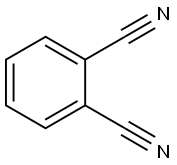
Фталонитрил
- английское имяPhthalonitrile
- CAS №91-15-6
- CBNumberCB2773751
- ФормулаC8H4N2
- мольный вес128.13
- EINECS202-044-8
- номер MDLMFCD00001771
- файл Mol91-15-6.mol
химическое свойство
| Температура плавления | 137-139 °C (lit.) |
| Температура кипения | 227.54°C (rough estimate) |
| плотность | 1.24 |
| Плотность накопления | 500kg/m3 |
| давление пара | <1 Pa (25 °C) |
| показатель преломления | 1.6231 (estimate) |
| Fp | 162°C |
| температура хранения | Store below +30°C. |
| растворимость | benzene: 50 mg/mL, clear |
| форма | Crystals or Crystalline Powder |
| цвет | White to beige |
| РН | 7 (H2O) |
| Растворимость в воде | 0.56 g/L (25 ºC) |
| БРН | 775028 |
| Пределы воздействия | ACGIH: TWA 1 mg/m3 |
| Стабильность | Stable. Incompatible with strong bases, strong acids, strong oxidizing agents, strong reducing agents. |
| Справочник по базе данных CAS | 91-15-6(CAS DataBase Reference) |
| Рейтинг продуктов питания EWG | 1 |
| FDA UNII | 978627YAJU |
| Справочник по химии NIST | Phthalonitrile(91-15-6) |
| Система регистрации веществ EPA | 1,2-Benzenedicarbonitrile (91-15-6) |
| UNSPSC Code | 12352117 |
| NACRES | NA.22 |
больше
| Коды опасности | T | |||||||||
| Заявления о рисках | 25-23/24/25 | |||||||||
| Заявления о безопасности | 36/37/39-45-28A | |||||||||
| РИДАДР | UN 3439 6.1/PG 2 | |||||||||
| WGK Германия | 1 | |||||||||
| RTECS | TI8575000 | |||||||||
| Температура самовоспламенения | >580 °C | |||||||||
| TSCA | Yes | |||||||||
| Класс опасности | 6.1 | |||||||||
| Группа упаковки | II | |||||||||
| кода HS | 29269095 | |||||||||
| Банк данных об опасных веществах | 91-15-6(Hazardous Substances Data) | |||||||||
| Токсичность | LD50 orally in Rabbit: 85 mg/kg | |||||||||
| NFPA 704: |
|
рисовальное письмо(GHS)
-
рисовальное письмо(GHS)

-
сигнальный язык
опасность
-
вредная бумага
H301:Токсично при проглатывании.
H412:Вредно для водных организмов с долгосрочными последствиями.
-
оператор предупредительных мер
P264:После работы тщательно вымыть кожу.
P270:При использовании продукции не курить, не пить, не принимать пищу.
P273:Избегать попадания в окружающую среду.
P301+P310:ПРИ ПРОГЛАТЫВАНИИ: Немедленно обратиться за медицинской помощью. Прополоскать рот.
P405:Хранить в недоступном для посторонних месте.
P501:Удалить содержимое/ контейнер на утвержденных станциях утилизации отходов.
Фталонитрил химические свойства, назначение, производство
Химические свойства
Phthalonitrile is a crystalline powder having a faint grayish yellow color and a slighty aromatic odor, similar to benzonitrile. Phthalonitrile was first described in 1896 when it was isolated during the diazotization of 2-aminobenzonitrile. The compound is sparingly soluble in water (ca. 1 g/L) and soluble in acetone, nitrobenzene, and benzonitrile. It cannot be distilled and polymerizes if heated above the melting point. It is not explosive and is difficult to ignite, but the dust can explode.Использование
Phthalonitrile is used as an intermediate for chemical synthesis in the production of building blocks for colorants and coatings, life science and agricultural chemicals. It is also used as a precursor to phthalocyanine pigments (which are precursors to the blue dye in jeans), fluorescent brighteners, and photographic sensitizers.Подготовка
Phthalonitrile can be produced from phthalic acid, phthalic anhydride, phthalamide, or phthalimide by reaction with ammonia and elimination of water at 300–500°C in the gas phase in the presence of a catalyst.
In a single-stage continuous process, o-xylene is converted to phthalonitrile by reaction with ammonia and oxygen in the gas phase in a fluidized-bed reactor. Generally, metal oxide mixtures containing vanadium, antimony, chromium, and molybdenum, with further active components such as iron, tungsten, and alkali-metal oxides, on an alumina or silica support are used as catalysts.
Реакции
The route from o-phthalodinitrile can be represented 4C8H4N2 +M → MPc, where M is a bivalent metal, metal halide, metal alcoholate, or an equivalent amount of metal of valence other than two in a 4:1 molar ratio.Профиль безопасности
Poison by ingestion, subcutaneous, and intraperitoneal routes. Questionable carcinogen with experimental tumorigenic data. When heated to decomposition it emits toxic fumes of CN- and NOx. See also NITRILES.Методы очистки
Crystallise the nitrile from EtOH, toluene or *benzene. It has also been distilled under high vacuum. It is steam volatile. [Beilstein 9 H 815, 9 II 602, 9 III 4199, 9 IV 3268.]Фталонитрил запасные части и сырье
Фталонитрил поставщик
| поставщик | телефон | страна | номенклатура продукции | благоприятные условия |
|---|---|---|---|---|
| +8615531157085 | China | 8804 | 58 | |
| +86-371-86557731 +86-13613820652 |
China | 20259 | 58 | |
| +86-(0)57185586718 +86-13336195806 |
China | 29792 | 60 | |
| +86-371-66670886 | China | 19902 | 58 | |
| +86-0371-55170693 +86-19937530512 |
China | 21632 | 55 | |
| +86-021-57951555 +8617317452075 |
China | 1803 | 55 | |
| +86-0551-65418679 +8618949832763 |
China | 2986 | 55 | |
| +86-0371-86658258 +8613203830695 |
China | 29871 | 58 | |
| 18871490254 | CHINA | 28172 | 58 | |
| +86-86-5926051114 +8618959220845 |
China | 6383 | 58 |
Фталонитрил Обзор)
1of4